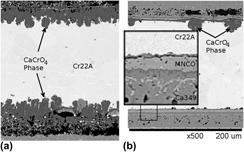Published online by Cambridge University Press: 11 November 2014

Practical implementation of oxide thermoelectrics on an industrial or commercial scale for waste heat energy conversion requires the development of chemically stable interfaces between metal interconnects and oxide thermoelements that exhibit low electrical contact resistances. A commercially available high-chrome iron alloy (i.e., Crofer® 22 APU) serving as the interconnect metal was spray coated with LaNi0.6Fe0.4O3 (LNFO) or (Mn,Co)3O4 spinel and then interfaced with a p-type thermoelectric material—calcium cobaltate (Ca3Co4O9)—using spark plasma sintering. The interfaces have been characterized in terms of their thermal and electronic transport properties and chemical stability. With long-term exposure of the interfaced samples to 800 °C in air, the cobalt–manganese spinel acted as a diffusion barrier between the Ca3Co4O9 and the Crofer® 22 APU alloy resulting in improved interfacial stability compared to that of samples containing LNFO as a barrier layer, and especially those without any barrier. The initial area specific interfacial resistance of the Ca3Co4O9/(Mn,Co)3O4/Crofer® 22 APU interface at 800 °C was found to be ∼1 mΩ·cm2.